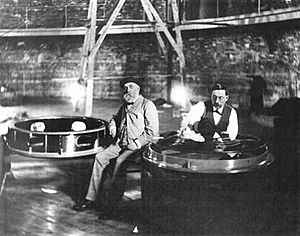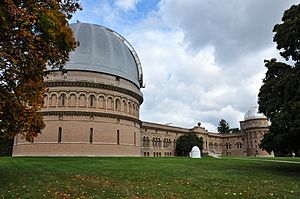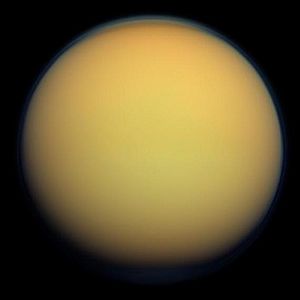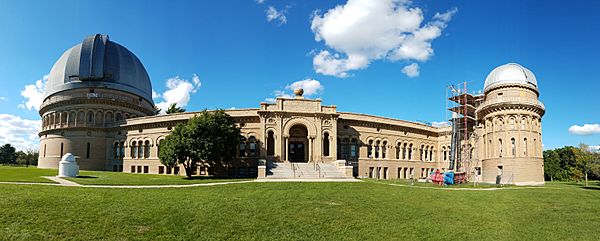Yerkes Observatory facts for kids
| Established | 1892 | ||||||||||||||||
|---|---|---|---|---|---|---|---|---|---|---|---|---|---|---|---|---|---|
Quick facts for kids
|
|||||||||||||||||
The Yerkes Observatory (YUR-keez) is a famous astronomical observatory in Williams Bay, Wisconsin, U.S.A. It was run by the University of Chicago from 1897 until 2020. In May 2020, a group called the Yerkes Future Foundation (YFF) took over its ownership.
This observatory is sometimes called "the birthplace of modern astrophysics." It was started in 1892 by astronomer George Ellery Hale and paid for by businessman Charles T. Yerkes. Yerkes Observatory changed how people thought about observatories. They became places where telescopes and labs worked together for physics and chemistry studies.
The main building has a huge 40-inch (102-cm) refracting telescope. This is the largest refractor ever used for astronomy. Two smaller domes hold 40-inch (102-cm) and 24-inch (61-cm) reflecting telescopes. There are also several smaller telescopes used for teaching. The observatory also keeps a collection of over 170,000 old photos taken on glass plates.
When it opened, the Yerkes 40-inch was the biggest refracting-type telescope in the world. Other large reflecting telescopes existed, like the Great Melbourne Telescope. In the U.S., the Lick refractor in California had a 91-cm lens. The Yerkes telescope was shown at the Columbian Exhibition in Chicago before it was installed.
Yerkes Observatory was a key place for astronomy research for over 100 years. However, by the 21st century, its research days were ending. The University of Chicago closed it to the public in October 2018. In 2020, the Yerkes Future Foundation (YFF) took over the observatory.
Contents
Amazing Telescopes at Yerkes
In the 1860s, Chicago had America's largest telescope, the Dearborn 18 1/2 inch refractor. Later, the U.S. Naval Observatory's 26-inch telescope discovered the moons of Mars. The late 1800s saw many new, larger telescopes in grand observatories. In the 1890s, Yerkes was built as a top place for art, science, and great instruments.
The Yerkes 40-inch telescope was later surpassed by the Harvard College Observatory's 60-inch reflector. But Yerkes remained a major research center for many decades. Besides the large refractor, Yerkes also did a lot of work observing the Sun.
The Giant 40-inch Refractor
Yerkes Observatory's 40-inch (~102 cm) refracting telescope has a special lens made by Alvan Clark & Sons. Its mount was built by the Warner & Swasey Company. This was the largest refracting telescope ever used for astronomy research.
Another huge refractor, the Great Paris Exhibition Telescope of 1900, was shown in Paris. However, it was not very successful and was taken apart. The Yerkes telescope's mount and tube were shown at the 1893 World's Columbian Exposition in Chicago before being set up at the observatory. The lens was finished later.
The glass for the Yerkes Great Refractor came from Paris, France. Alvan Clark & Sons in Massachusetts then shaped it into the largest telescope lens ever made. This lens was put on an equatorial mount by Warner & Swasey. The telescope's lens is 40 inches (~102 cm) wide. It has a focal length of 19.3 meters, which means it has a focal ratio of f/19.
The lens is an achromatic doublet, meaning it has two parts to reduce color problems. It weighs 225 kilograms. This was the last big lens Clark made before he died in 1897. Glass lens telescopes were highly respected. Older metal mirror telescopes, like the Leviathan of Parsonstown, were harder to use for good astronomy.
Some tools used with the 40-inch refractor in the 1890s included:
- Filar Micrometer
- Solar spectrograph
- Spectroheliograph
- Stellar spectrograph
- Photoheliograph
In the late 1960s, the 40-inch refractor was updated with new electronics. Its manual controls were removed, and electric operations were added.
The 41-inch Reflector
In the late 1960s, a 40-inch reflecting telescope was added. It was finished by 1968. While its clear viewing area is 40 inches, the mirror itself is 41 inches wide. This is why it's often called the "41-inch" to avoid confusion with the 40-inch refractor. The mirror is made from special low-expansion glass.
The first instruments for the 41-inch reflector included:
- Image tube spectrograph
- Photoelectric photometer
- Photoelectric spectrophotometer
The 40-inch reflector uses the Ritchey-Chretien optical design. This telescope helped start the field of adaptive optics, which corrects for blurry images caused by Earth's atmosphere.
Other Instruments and Equipment
A 12-inch refractor was moved to Yerkes from Kenwood Observatory in the 1890s. The observatory also built a two-foot reflecting telescope itself. Its clear viewing area was 23.5 inches. The glass for this telescope was shaped at Yerkes.
At one time, the Observatory had an IBM 1620 computer, which was later replaced by an IBM 1130 computer in the 1960s.
Later, another 24-inch reflecting telescope was added by Boller & Chivens. This telescope was used for visitor programs. It has a Cassegrain optical setup and a 24-inch (61 cm) clear opening.
A 7-inch (18 cm) Schmidt camera was also at Yerkes Observatory.
The Snow Solar Telescope was first at Yerkes. It was moved to California in 1904. This led to the design of vertical solar tower telescopes, which are still used today to study the Sun.
Another important tool was the Bruce photographic telescope. It had two lenses for photography (10-inch and 6.5-inch) and a 5-inch guide scope. This telescope was used to take pictures on large glass plates. Astronomer Edward Emerson Barnard used it to create a sky atlas and a catalog of dark nebula.
Observatory Dedication
The Yerkes Observatory was officially opened on October 21, 1897. A big party was held with university staff, astronomers, and scientists.
Before the dedication, a meeting of astronomers and astrophysicists took place at Yerkes from October 18–20, 1897. This meeting helped lead to the creation of the American Astronomical Society.
Even though it was dedicated in 1897, the observatory was founded in 1892. Astronomical observations actually began in the summer of 1897, before the official opening.
Research and Discoveries
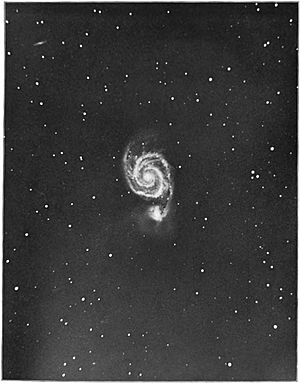
In recent years, research at Yerkes has included studies on the interstellar medium (the gas and dust between stars), how globular clusters form, infrared astronomy, and near-Earth objects. The University of Chicago also had an engineering center at the observatory. It built and fixed scientific instruments. For example, in 2012, engineers finished work on the High-resolution Airborne Wideband Camera (HAWC) for the Stratospheric Observatory for Infrared Astronomy (SOFIA).
Researchers also use the observatory's huge collection of over 170,000 old photographic plates. These plates date back to the 1890s. In recent years, educational programs and tours have become more common than research.
In June 1967, Yerkes Observatory hosted the largest meeting of the American Astronomical Society at that time. Over 200 research papers were discussed.
The Yerkes spectral classification (also called the MKK system) was created in 1943 by William Wilson Morgan, Philip C. Keenan, and Edith Kellman from Yerkes Observatory. This system helps classify stars based on their temperature and luminosity (how bright they are). It was later renamed the Morgan–Keenan classification, or MK, in 1953.
Research from Yerkes Observatory has been mentioned in over 10,000 scientific papers.
In 1899, observations of Neptune's moon Triton were published using data from Yerkes. In 1906, a catalog of over 13,600 stars was published. Early on, important work on the Sun was also done here.
Many asteroids were discovered at Yerkes. For example, 1024 Hale, a large asteroid about 45 km (28 miles) wide, was found in 1923 by George Van Biesbroeck. It was named after George Ellery Hale, who helped found Yerkes. Other asteroids discovered include 990 Yerkes, 991 McDonalda, and 992 Swasey.
Famous People at Yerkes
Many famous astronomers worked or visited Yerkes. These include:
- Albert Michelson
- Edwin Hubble (who studied here and for whom the Hubble Space Telescope is named)
- Subrahmanyan Chandrasekhar (for whom the Chandra Space Telescope is named)
- Otto Struve
- Gerard Kuiper (who suggested the Kuiper belt, where Pluto is)
- Nancy Grace Roman (NASA's first Chief of Astronomy, who studied here)
- Carl Sagan, a famous science communicator.
In May 1921, the famous scientist Albert Einstein visited the Yerkes Observatory.
Here are some of the directors of Yerkes Observatory:
- 2012 - 2018: Doyal Al Harper
- 2001 - 2012: Kyle M. Cudworth
- 1989 - 2001: Richard G. Kron
- 1982 - 1989: Doyal Al Harper
- 1974 - 1982: Lewis M. Hobbs
- 1972 - 1974: William Van Altena
- 1966 - 1972: C. Robert O'Dell
- 1963 - 1966: William Hiltner
- 1960 - 1963: William W. Morgan
- 1957 - 1960: Gerard P. Kuiper
- 1950 - 1957: Bengt Stromgren
- 1947 - 1950: Gerard P. Kuiper
- 1932 - 1947: Otto Struve
- 1903 - 1932: Edwin B. Frost
- 1897 - 1903: George Ellery Hale
Observatory Closure
In March 2018, the University of Chicago announced it would stop running the observatory after October 1, 2018. They looked for a new owner. In May 2018, the Yerkes Future Foundation, a local group, offered to take over. They wanted to keep the site open to the public and continue educational programs.
Since no new operator was found by October 1, the observatory closed to the general public. However, some research, like using the historical glass plate archives, continued. The Yerkes education staff formed a new group, GLAS, to keep their programs going elsewhere.
In May 2019, the University kept talking with interested groups, mainly the Yerkes Future Foundation. A key point was including the Yerkes family in talks. Charles T. Yerkes' original gift agreement stated that if the university stopped using the property for astronomy, it would go back to his family.
A new gate with a sign saying "Facilities Closed To The Public" was put up after October 1, 2018.
Architecture and Landscape
The Yerkes Observatory buildings and grounds are famous for more than just the Great Refractor. They also have beautiful sculptures and architecture. The landscape was designed by the famous Olmsted firm, known for New York's Central Park.
The observatory building was designed by architect Henry Ives Cobb. It mixes different styles and has many decorations, including animal and mythological designs. You can see carvings like lion gargoyles on the building. There are also sculptures honoring people who helped build the telescope and the observatory.
The location by Lake Geneva is very pleasant. Even though it's not high up like modern observatories, it has good weather. It was also far from the bright lights and pollution of Chicago. In 1888, a railway line reached Williams Bay, making it easier to get to the observatory from Chicago.
The offices for The Astrophysical Journal were located at Yerkes Observatory until the 1960s.
The grounds were once known for having several state record trees. The tree plan was developed in the 1910s. It included trees like white fir, yellowwood tree, golden rain tree, European beech, ginkgo, and chestnut trees. The full landscape plan was not finished by the 1897 dedication. Roads were still being built as late as 1908.
Yerkes' Place in Telescope History
The Yerkes Observatory's 40-inch refractor was a huge achievement. It was 4 inches larger than the well-known 36-inch Lick refractor in California. This meant it could gather 23% more light! Both telescopes had special lenses made by Alvan Clark.
The 19th century saw a shift from refractor telescopes (using lenses) to reflector telescopes (using mirrors). Yerkes was perhaps the greatest of the great refractors. It was the largest telescope of its kind.
When it started working in 1896, Yerkes was tied for being the largest telescope in the world with the Paris Observatory reflector (48 inches, 122 cm).
In the late 1800s, there were many questions about the best way to build telescopes. Older metal mirrors reflected less light and needed a lot of care. A big step forward came with a way to coat glass with a thin metal film, called silver on glass. This led to bigger glass reflectors. However, silver coatings had to be redone every couple of years.
Yerkes' Lasting Impact
By 1905, the largest telescope was the Harvard 60-inch Reflector. In 1908, Mount Wilson Observatory also built a 60-inch reflector. Throughout the 20th century, even larger reflectors were built. This was helped by new mirror technology, like using vapor-deposited aluminum on special glass. This was first used for the 200-inch (5-meter) Hale telescope in 1948.
Later in the 20th century, space observatories became a major advance. Less than a century after Yerkes, the Hubble Space Telescope, with a 2.4-meter reflector, was launched into space.
The Yerkes Observatory was described as "castle-like" with its beautiful grounds, architecture, and statues. It was built on 77 acres with artistic landscaping. The long telescope tubes and grand domes made it a place where astronomers and the public came to learn about the stars.
Great discoveries were made during this time, like astrophotography and finding new types of stars. The powerful telescopes helped people understand space and Earth's place in the Milky Way Galaxy. One big achievement was when Gerard Kuiper discovered that Saturn's moon Titan has an atmosphere.
Images for kids
See also
 In Spanish: Observatorio Yerkes para niños
In Spanish: Observatorio Yerkes para niños




